I used to enjoy RPGs. Even now, I play one every once in a while, but there’s just one little thing that’s really starting to get to me. That stupid menu-driven battle system that most of ’em use. I never thought that I needed any sort of pace, never mind a fast one, but that’s just how it is. And RPGs, my friends, are certainly not fast-paced. So it was about time that I found a game that would last me a long time, afford me a chance to play through something with more than a slight suggestion of a story, and let me go on a whole bunch of side-quests that would be useful if they could be done before the end of the game. And boy, did Namco deliver.
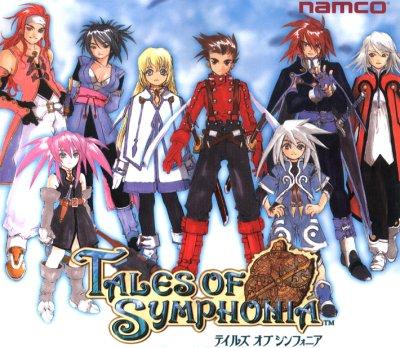
Tales of Symphonia is definitely my new favourite RPG of all time. It blows away the Mario RPGs, kicks Pokémon in the ass, and utterly destroys Final Fantasy. Gone are the days of mindlessly mashing the “confirm” button over and over to win the battles, and in comes the Tales series’ famous Linear Motion Battle system. In 3D. Of course, you can still just mash the same button over and over, but this can go far beyond that. The way it works, is basically like every other RPG in that you get taken to a separate field of play, where you square off against the enemy. The battlefield is in 3D, but your character functions on a 2D plane. You choose an enemy to lock-on to, and you move forward or away from that enemy. Of course, there are other baddies on the field as well, and you can change the lock-on to focus on them instead. If you’ve played Super Smash Bros, you’ll notice that the two are very similar.
So once you choose an enemy, it’s on to the fighting! But rather than simply choosing commands from a menu, you are actually in control of one of your characters. You can run, attack, jump, block, use techniques, and all sorts of other good stuff. The controls are simple, A is for basic attacks, which can be diversified with the control stick, and B does techniques, also using the control stick to use different techniques. X blocks, while tapping up on the control stick makes you jump. R is used to change your target, and the d-pad is for quick tactic changing. The Z button will allow you to use a Union attack, where your whole party unleashes a quartet of attacks upon a stunned foe. The Y button opens a menu which lets you use items and make more complex strategy changes during battle.
Symphonia’s battles are more focused on the usage of special attacks and magic than basic attacks. Of course, these skills are dictated by TP, Technique Points. You wouldn’t want to abuse them, right? While your party members will work on their own most of the time, you can map your own techs to the B button, and even set a couple commands to the C Stick. Like Smash Bros, you can have four different techniques assigned to the B button, but unlike the fighter, you can choose from a whole list of different skills. You can even choose from two different branches of skills based upon how you’re raising your characters. If your character it aligned towards the S-Type (Strike), he/she will learn more physical and damaging attacks than one aligned towards the T-Type (technique). It’s a nice way to add a little bit of customization to the game.
While you can only directly control one character at any given time, there are almost always three other characters in your party. They’re normally controlled by the AI, and I have to admit that it does a pretty good job, even though it does like to spend TP rather frivolously (but it slowly regenerates after each battle). And if you don’t like how the AI is doing, you can always (at any time, except for story sequences) go into the menu and change how they fight. You can set how they use skills, how they attack, what kind of distance they keep from the enemy and even which enemies they should attack. There are even quick settings so that you can change your whole party into a defence or attack mode at the press of a button.
Your party is all very customizable, and if you still don’t like it, plug in a few controllers and get your friends in on the action. Yep, there’s multiplayer. And it doesn’t even require everyone to have a GBA. Hooray. It does require other people who want to play, though. So while it won’t cost you extra money, you’ll have no luck if you’re the only one in your group of friends/family who likes video games. While it isn’t very clear how to set up other players, it’s as simple as plugging in a controller and setting the character to “manual” or “semi-auto” mode. There is only one little problem with the multiplayer mode, and it’s that the camera has a bad tendency to focus and zoom in on the first player. Now if player one were to be a magic using character, the camera would stay zoomed out most of the time, but if he’s playing on the front lines, well, you’re not going to see much of the other players. If you can look past this little oops, it’s really an excellent feature.
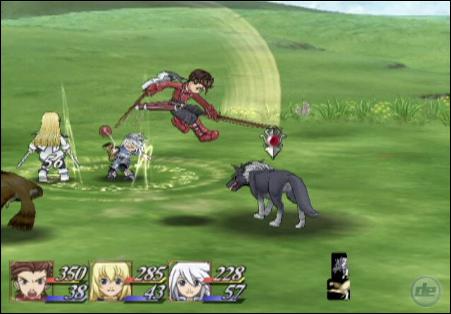
Well look at all this text, and imagine that I’ve only been talking about the battle system. Huh. Well I guess it would be best to tell you a little bit about the rest of the game. For starters, it’s the second (I think) two-disc GameCube exclusive. To translate for the casual gamer, that means it’ll take you a long time to finish it. I myself took about 50 hours to go through it once, and I missed pretty much every side-quest and optional boss. That and it’s got a hard mode and “mania” mode (which unlocks after you beat it once) to play through, so if you want to say you’ve truly seen it all, you have to play through three times. Also adding to the replay is the New Game+ feature, but it works a bit differently here. During the game, you earn GRADE in battle. You can use it to buy a few things in-game, but it’s better to save it all for the end. For once you start a new game from your finished save, you’re taken to a GRADE shop, where you can spend you hard-earned points to carry over skills, various data, money, and even get upgrades like double EXP points. Taken into account that you have to be good to accumulate a lot of GRADE, these bonuses are very useful if you don’t want to start some things from scratch (like the Collector’s Book and Monster List).
As for aesthetics, the entire game is done with a beautiful cel-shading technique. It looks even better than the Wind Waker, and I had thought that that was the pinnacle of cel-shading effects. There is a lot of hype surrounding the anime cutscenes in the game, but to tell the truth, there really aren’t that many, maybe four or five at most. And most of them are somewhat short and uneventful. The only two that stand out are the first, which is the opening video, and the last, the closing video. While they aren’t too overwhelming on the whole, they are done very nicely and fit in well with the rest of the game. Overall, the graphics are some of the nicest non-realisticness you’re ever going to see. Though it does bother me that the characters’ expressions never change. The sound, on the other hand, is a little less impressive. A lot of the game is voice-acted, and as far as I can tell, it’s done very well. The music is a bit on the down side though. The best pieces in the game are the battle themes, particularly the fights with the summon spirits. They’re all very catchy and never get old, which is good, because there is a lot of battling. The overworld/town/event music is much less enjoyable though. Not that it’s bad or anything, but it just doesn’t seem right at some times. In fact, there are a couple town themes that are downright annoying.
I’m reviewing an RPG here, so I bet you’re expecting a drawn-out impression of the plot, right? To put it simply, it’s good. I’m not the best at knowing a good story from a bad one, but Symphonia’s seems pretty sound. It starts out with the general plot all laid out for you, but as time goes on, things change and plot twists are thrown in like chocolate chips into cookie batter. There are some that will surprise you a little, but there’s a little foreshadowing for almost every twist, so nothing is going to make you fall over in shock. What really shines here is character development. All of the characters grow substantially during the course of the game, and they all manage to maintain their little tics throughout its entirety. Even most of the less-important NPCs (the ones just good enough to get names) have been given personalities that could dwarf that of any high-school jock. There are even little skits that let you in on what the characters think of each other and their quest. There are also spots where you have a chance to better (or worsen, if you so choose) the relationship between two characters.
And that’s about all that I can think to say for now. In conclusion, for the first original RPG on the GameCube, Tales of Symphonia sure cleans up for itself. This one’s got some massive potential, and keeps good the Tales name. Heck, back in the day, I thought Tales of Phantasia for the SNES was pretty awesome, and seeing how similar the two games are made me happy to see that the formula is obviously working. I may have missed them all, but if the Tales games in between Phantasia and Symphonia were as good as those two, this is definitely one series that is not to be messed with. I’d easily recommend this game to anyone who owns a GameCube. Even if you don’t like RPGs. This one’s got all the action that those other ones are missing. Yeah. Definitely go buy it. Awesome game + multiplayer option = meaty gaming goodness. That’s all you need to know. Buy or buy not. There is no rent.

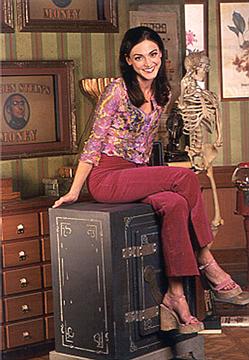
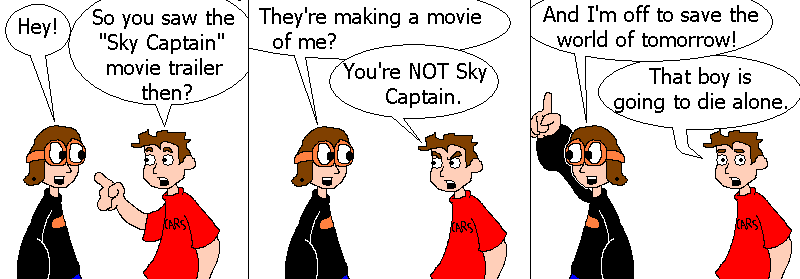
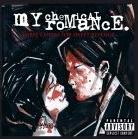 I’ve honestly only been listening to them for 4 or 5 days, but I cannot deny that MCR is one kickass band. Plainly stated, they rock. Solid guitar work, some impressive drumming, and excellent vocals all wrap themselves together quite nicely to form one helluva band. The genre issue is a little up in the air with these guys, as they sound like they could be either punk or rock, while having a slight tinge of goth and/or emo in the lyrics. In the end though, genre doesn’t matter much, because they still kick ass.
I’ve honestly only been listening to them for 4 or 5 days, but I cannot deny that MCR is one kickass band. Plainly stated, they rock. Solid guitar work, some impressive drumming, and excellent vocals all wrap themselves together quite nicely to form one helluva band. The genre issue is a little up in the air with these guys, as they sound like they could be either punk or rock, while having a slight tinge of goth and/or emo in the lyrics. In the end though, genre doesn’t matter much, because they still kick ass.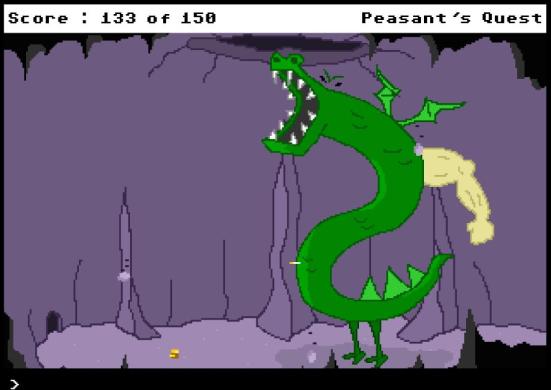


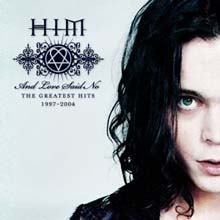 The title really says it all. I don’t buy a lot of CDs. Not to say that I burn them all (only OC Remix CDs these days…), but music just isn’t that big of a priority for me. I do listen to it a lot, but I’m rather satisfied with the library I have now. All I really want for it is to complete my Queen and HIM collections. And a couple days ago, I got one step closer. This here, if you can’t read the text on the pic, is HIM’s greatest hits CD, entitled “And Love Said No”. I can easily say that it is the best CD that I own, and possibly one of the best CDs that I’ve ever listened to. If you haven’t ever listened to HIM, go check them out right now. I know you have the tools to do so.
The title really says it all. I don’t buy a lot of CDs. Not to say that I burn them all (only OC Remix CDs these days…), but music just isn’t that big of a priority for me. I do listen to it a lot, but I’m rather satisfied with the library I have now. All I really want for it is to complete my Queen and HIM collections. And a couple days ago, I got one step closer. This here, if you can’t read the text on the pic, is HIM’s greatest hits CD, entitled “And Love Said No”. I can easily say that it is the best CD that I own, and possibly one of the best CDs that I’ve ever listened to. If you haven’t ever listened to HIM, go check them out right now. I know you have the tools to do so.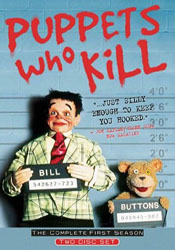 It’s entirely obvious why I love the show. The first reason would be that it’s very, very funny. And not that Buzz kind of “laugh out loud for thirty minutes straight” kind of funny. It’s more of a psychotic kind of funny. A lot of the humour is in the pain of the characters (that one was kind of obvious), some especially clever one-liners, and just flat out potty mouth and toilet humour. The first time you watch it, you almost wonder who would come up with some of the crazy crap that PWK is just gushing with, but in the end you get this satisfied feeling that leaves you thinking “That was a good show. I should watch it regularly.” Well, at least that’s how it worked for me. I was hooked after only one episode, at which point I was convinced that it was too good to be Canadian programming. And when I saw that there was a DVD of the first season, I knew that it would have to be mine… one way or another.
It’s entirely obvious why I love the show. The first reason would be that it’s very, very funny. And not that Buzz kind of “laugh out loud for thirty minutes straight” kind of funny. It’s more of a psychotic kind of funny. A lot of the humour is in the pain of the characters (that one was kind of obvious), some especially clever one-liners, and just flat out potty mouth and toilet humour. The first time you watch it, you almost wonder who would come up with some of the crazy crap that PWK is just gushing with, but in the end you get this satisfied feeling that leaves you thinking “That was a good show. I should watch it regularly.” Well, at least that’s how it worked for me. I was hooked after only one episode, at which point I was convinced that it was too good to be Canadian programming. And when I saw that there was a DVD of the first season, I knew that it would have to be mine… one way or another.